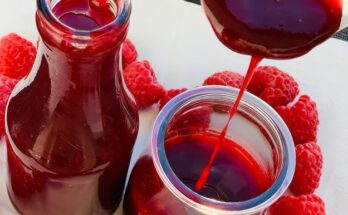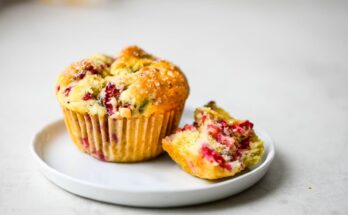Coffee Jelly Recipe: Coffee jelly is a delightful dessert that combines the rich, aromatic flavor of brewed coffee with the fun, bouncy texture of gelatin. It’s like your morning cup of coffee transformed into a refreshing, wiggly treat. This dessert originated in Japan in the 1960s, quickly capturing hearts for its unique combination of bitter coffee notes balanced by sweet syrup or cream. Unlike heavy, overly sugary puddings, coffee jelly is light, making it a perfect end to a meal or an afternoon pick-me-up.
The base is simple—coffee, sugar, and gelatin—yet the possibilities are endless. You can cube it, layer it with cream, or even blend it into drinks. This versatility has made coffee jelly a favorite in cafés, dessert shops, and home kitchens alike.
If you’ve never tried it before, imagine the smoothness of panna cotta but with the sophisticated bitterness of coffee. It’s not just dessert—it’s a conversation starter on a plate.
Why Coffee Jelly is Popular Worldwide
While coffee jelly was born in Japan, its appeal has gone global. In Asia, you’ll find it in bubble tea shops, parfaits, and even in ice cream blends. In the West, it’s often served as a coffee-flavored gelatin topped with whipped cream or milk.
Its popularity comes down to three key factors:
- Flavor – The balance between the bitterness of coffee and the sweetness of sugar or cream creates a satisfying, layered taste.
- Texture – The jiggly, soft cubes offer a playful contrast to creamy toppings or icy drinks.
- Simplicity – With just a few ingredients, anyone can make it without specialized cooking skills.
In an era where café culture is booming, coffee jelly stands out as a creative way to enjoy coffee beyond the mug. It’s both nostalgic for those who grew up with it and exciting for newcomers seeking something different.
Ingredients You’ll Need
Main Ingredients
To make classic coffee jelly, you’ll need:
- Coffee – Freshly brewed for best flavor; instant coffee works too if you’re short on time. Use strong coffee for a richer taste.
- Gelatin – Either powdered gelatin or agar-agar (for a vegetarian/vegan option).
- Sugar – Adjust to taste; white sugar is traditional, but brown sugar adds a deeper note.
- Water – For brewing coffee and dissolving gelatin.
Here’s a suggested ratio for a standard batch:
| Ingredient | Amount |
|---|---|
| Strong brewed coffee | 2 cups |
| Sugar | 3–4 tablespoons |
| Gelatin powder | 1 tablespoon |
| Water (extra) | ½ cup |
The key is balance: too little gelatin and it won’t set; too much and it becomes rubbery. Sugar levels depend on how sweet you want your dessert.
Optional Additions for Extra Flavor
You can elevate your coffee jelly by adding:
- Vanilla extract for a subtle aroma.
- Cinnamon or nutmeg for a warm, spiced twist.
- Condensed milk for creaminess.
- Coffee liqueur for an adult-friendly version.
These extras transform your dessert from simple to gourmet without adding much effort. Think of them as accessories to your coffee jelly’s little black dress.
Essential Tools and Equipment
Basic Kitchen Tools
You don’t need a fully equipped kitchen to make coffee jelly, but having these tools makes the process easier:
- Saucepan (for heating coffee and dissolving gelatin)
- Measuring cups and spoons
- Mixing spoon or whisk
- Heatproof bowl
These basics are usually found in most kitchens, so you won’t need to buy specialized gear.
Recommended Utensils for Perfect Texture
If you want your coffee jelly to look as good as it tastes, consider:
- Jelly molds for shaping individual servings
- Square baking dish for cubing jelly into neat pieces
- Serving glasses for a café-style presentation
- Strainer to remove any undissolved gelatin clumps
Using molds or glasses can elevate presentation—because we all know food tastes better when it looks Instagram-worthy.
Step-by-Step Guide to Making Coffee Jelly
Step 1 – Preparing the Coffee Base
Start by brewing your coffee. For the best flavor, use freshly ground beans and brew them strong—think double the strength of your usual cup. This ensures the coffee flavor stands out even after adding sugar and gelatin.
Once brewed, pour the coffee into a saucepan and add sugar. Stir over medium heat until the sugar dissolves completely. Taste and adjust sweetness; remember, toppings like whipped cream can add more sweetness later, so it’s okay to keep the base slightly less sweet.
Avoid letting the coffee boil vigorously—it can develop a burnt taste. Gentle heating is the secret to keeping the flavor smooth.
Step 2 – Mixing with Gelatin
Once your coffee base is ready, it’s time to incorporate the gelatin. In a small bowl, mix gelatin powder with about ½ cup of warm water (not boiling). Stir until completely dissolved—this prevents clumping when you add it to the coffee. If you’re using agar-agar, you’ll need to simmer it for a few minutes to activate its setting properties.
Now, slowly pour the dissolved gelatin mixture into the hot coffee, stirring constantly to ensure even distribution. This step is crucial; uneven mixing can lead to patches of unset jelly or grainy texture. The goal is to create a smooth, uniform liquid that will set evenly in the refrigerator.
Pro tip: If you want an ultra-clear jelly, strain the mixture through a fine mesh sieve before pouring it into your molds or container. This removes any stray coffee grounds or gelatin bits, leaving you with a picture-perfect dessert.
Step 3 – Setting the Jelly
Pour the gelatin-coffee mixture into your chosen molds, a square baking dish, or serving glasses. If you’re making cubes, a baking dish works best—you can cut it into perfect squares later. For individual servings, small glasses or ramekins are great.
Cover and refrigerate for at least 3–4 hours, or until the jelly is firm. Avoid placing it in the freezer; rapid chilling can cause the gelatin to separate, creating an unappealing texture.
You’ll know it’s ready when the surface is smooth and slightly bouncy to the touch. If you press lightly and it springs back, congratulations—you’ve nailed the perfect jelly texture.
Step 4 – Serving Ideas
Coffee jelly can be enjoyed in countless ways, and presentation plays a big role in making it irresistible. Here are some serving ideas:
- Classic Style – Cut into cubes and serve in a bowl with a drizzle of sweet cream or condensed milk.
- Parfait Style – Layer coffee jelly cubes with whipped cream, ice cream, and fresh fruit for a café-style dessert.
- Drinkable Dessert – Place cubes in a tall glass, add milk or coffee, and enjoy it with a straw like bubble tea.
- Fancy Plating – Serve molded jelly shapes on a plate with chocolate sauce drizzle.
The beauty of coffee jelly is that it can be dressed up for a dinner party or kept simple for a weekday treat.
Tips for Perfect Coffee Jelly
Avoiding Common Mistakes
Even though coffee jelly is simple, a few common errors can spoil the result:
- Too much gelatin – Makes the texture rubbery and unpleasant.
- Not dissolving gelatin properly – Leads to grainy bits in the jelly.
- Overboiling coffee – Can cause bitterness and loss of aroma.
- Adding gelatin to boiling liquid – May weaken its setting ability.
The secret is patience: dissolve gelatin in warm water, keep coffee just below boiling, and stir gently.
Adjusting Sweetness and Coffee Strength
The best part about homemade coffee jelly is customizing it to your taste. For a stronger kick, use espresso shots instead of brewed coffee. For a milder version, dilute your coffee slightly before mixing with gelatin.
Sweetness can also be tailored—if you love creamy desserts, keep the jelly less sweet and rely on your toppings for flavor balance. If you prefer it as a standalone dessert, add more sugar to the coffee base itself.
You can even experiment with flavored syrups like caramel or hazelnut for a café-inspired twist.
Variations of Coffee Jelly Recipes
Coffee Jelly with Cream
One of the most beloved versions of coffee jelly is pairing it with fresh cream. The silky cream perfectly balances the bitterness of coffee, creating a smooth, indulgent mouthfeel. To prepare this variation, cube the jelly and place it in a chilled glass. Pour fresh cream (or half-and-half) over the top until the cubes are just submerged. Add a sprinkle of cocoa powder for a visual and flavor boost.
For an extra layer of indulgence, use sweetened whipped cream or even mascarpone for a richer, dessert-like experience. Some people prefer a light drizzle of condensed milk instead of cream, which adds a caramel-like sweetness.
This variation works well as a dessert for dinner parties, especially if you serve it in elegant glasses with a long dessert spoon.
Iced Coffee Jelly Drink
Think of this as a coffee shop drink with a playful twist. Start by making coffee jelly cubes as usual. Once set, place the cubes into a tall glass, filling about one-third of the way. Add ice cubes, then pour in cold milk, iced coffee, or even a milk-tea mix.
If you’re feeling adventurous, top it with whipped cream and a drizzle of chocolate or caramel sauce. This drink not only looks beautiful with its contrasting layers but also offers a fun texture as you sip and chew.
Many cafés in Asia use this style to attract coffee lovers who also enjoy bubble tea. It’s refreshing, Instagram-worthy, and incredibly easy to make at home.
Vegan Coffee Jelly Option
For those avoiding animal products, agar-agar is your best friend. This plant-based alternative to gelatin is derived from seaweed and sets at room temperature, though it’s still best chilled for maximum enjoyment.
To make vegan coffee jelly, substitute gelatin with agar-agar powder in the same recipe. Keep in mind that agar-agar sets more firmly than gelatin, so you may want to reduce the amount slightly for a softer texture. Also, since agar-agar needs to be boiled to dissolve completely, mix it into the coffee base while it’s still on the heat, then stir well before pouring into molds.
Pair vegan coffee jelly with coconut cream or almond milk for a dairy-free delight.
Coffee Jelly Around the World
Japanese Coffee Jelly Tradition
Japan is the birthplace of modern coffee jelly, and it remains a beloved dessert there. You’ll find it in convenience stores, cafés, and even school cafeterias. In Japan, it’s often served with a generous pour of sweetened cream and sometimes topped with a scoop of vanilla ice cream.
Its popularity in Japan stems from its refreshing, light quality, making it ideal for hot summers. It’s also a nostalgic dessert for many, as it has been around for decades and remains unchanged in its classic form.
Interestingly, Japanese coffee jelly tends to be less sweet than Western versions, allowing the coffee flavor to shine through.
Western Café Adaptations
In Western countries, coffee jelly is less common but is gaining attention thanks to social media and global food trends. Cafés in cities like New York, London, and Sydney are starting to feature coffee jelly parfaits, iced drinks, and even coffee jelly affogatos.
Western versions often use bolder flavors and heavier toppings—think caramel drizzle, chocolate shavings, or a mountain of whipped cream. Some restaurants even incorporate coffee jelly into tiramisu or layer it in cakes.
This cultural crossover shows that coffee jelly is not just a passing fad—it’s a versatile dessert with endless potential.
Nutritional Value of Coffee Jelly
Calorie Count and Macronutrients
Coffee jelly is surprisingly light compared to many desserts. A standard serving (about 150g) made with black coffee, sugar, and gelatin contains roughly:
| Nutrient | Amount |
|---|---|
| Calories | 80–100 |
| Carbohydrates | 20g |
| Protein | 2g |
| Fat | 0–1g |
This makes it a guilt-free treat for those watching their calorie intake—especially if served without heavy cream or high-sugar toppings.
Since coffee itself has no calories, most of the dessert’s calories come from sugar and gelatin.
Health Benefits and Concerns
Coffee jelly retains many of the benefits of coffee, such as antioxidants and potential metabolism-boosting effects. However, those benefits depend on portion sizes and toppings.
If you’re sensitive to caffeine, be mindful of how strong your coffee base is. Similarly, people on low-sugar diets may want to reduce sugar or use sweeteners like stevia.
Overall, coffee jelly is a healthier dessert option than cakes or pastries, provided it’s enjoyed in moderation.
How to Store Coffee Jelly
Refrigeration Tips
Coffee jelly is best enjoyed fresh, but it can be stored in the refrigerator for later. To keep it in top condition, store it in an airtight container or cover the dish with plastic wrap. This prevents it from absorbing odors from other foods in the fridge.
If you’ve already cut the jelly into cubes, store them in a sealed container with a little syrup or cream to prevent them from drying out. Avoid stacking them directly without any liquid, as this can cause them to stick together.
Always refrigerate coffee jelly promptly—leaving it at room temperature for too long can cause it to soften or lose its firm texture.
Shelf Life and Safety
Homemade coffee jelly generally lasts 3–4 days in the refrigerator. After that, the texture may become watery and the flavor may start to fade. If you notice any sour smell or discoloration, it’s best to discard it.
If your recipe contains dairy (like cream or milk) mixed in with the jelly, its shelf life will be shorter—closer to 2 days—due to the perishable nature of dairy products.
For longer storage, you can make the coffee jelly without cream and only add toppings when serving. This way, you maximize freshness and flavor.
FAQs about Coffee Jelly Recipe
Can I make coffee jelly without gelatin?
Yes! You can use agar-agar powder for a plant-based alternative. It sets more firmly, so adjust the amount for a softer texture.
Does coffee jelly have caffeine?
Yes, it contains caffeine unless you use decaffeinated coffee. The caffeine content depends on the strength of your coffee base.
Can I freeze coffee jelly?
Freezing is not recommended—it can ruin the texture, making it grainy and watery once thawed.
Is coffee jelly suitable for kids?
In small amounts, yes, but opt for a decaf version to avoid giving children too much caffeine.
How can I make my coffee jelly sweeter without adding more sugar?
Use sweetened cream, condensed milk, or flavored syrups when serving.
Conclusion
Coffee jelly is more than just a dessert—it’s a versatile, refreshing, and surprisingly easy treat that can be enjoyed in countless ways. Whether you prefer it simply with cream, as part of an iced drink, or transformed into a vegan-friendly version, there’s a coffee jelly recipe for everyone.
Its light texture and bold flavor make it perfect for hot summer days or as a unique twist on your usual coffee fix. Plus, with just a few ingredients and minimal effort, you can prepare a dessert that looks sophisticated yet feels fun and approachable.
So next time you’re craving something sweet but not too heavy, skip the cake and try making coffee jelly—you might just find your new favorite treat.



